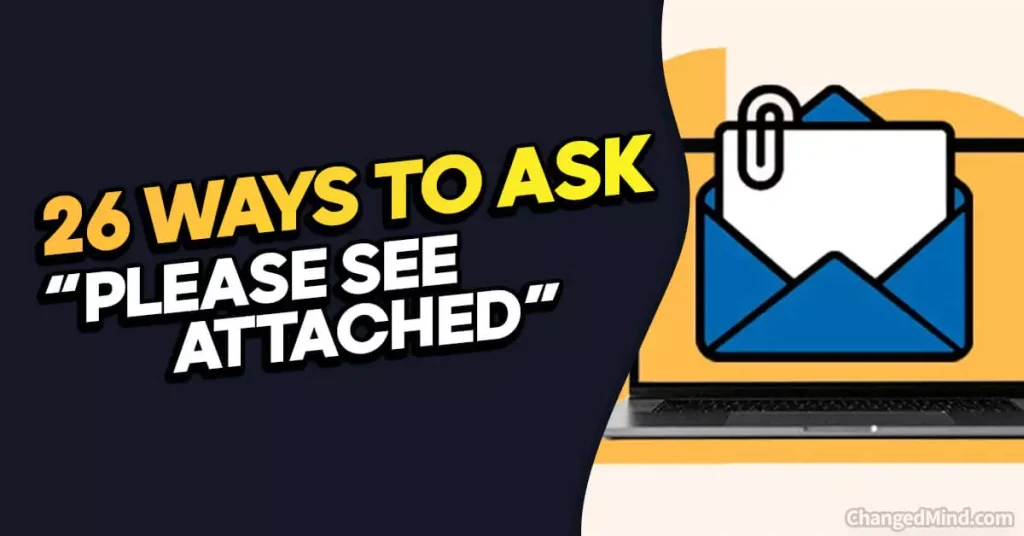Tired of sounding like a broken record with your email attachments? Join the club! But fear not, fellow email aficionados, because we’ve got a treat for you.
In this article, we’re unveiling 26 charming alternatives to the age-old “Please See Attached.”
From the delightfully witty to the elegantly subtle, we’ve got your email etiquette upgrade right here.
No more mundane messages—just fresh, creative ways to attach those files. So, why keep reading?
Well, we’re about to explore:
- How to add a touch of flair to your emails.
- Elevating your email communication skills.
- Making your messages memorable.
- Boosting your professionalism.
- Ensuring your attachments get noticed.
- And much more! Let’s dive into the art of email attachment language!
Using the phrase “Please see attached” in email communication can come across as vague, impersonal, and overused. It’s essential to find alternative ways to convey the same message effectively.
Here are the reasons why you should avoid using “Please see attached”:
- Lack of Clarity: The phrase “Please see attached” does not provide specific information about the attachment, leaving the recipient unsure of what they should expect.
- Impersonal Communication: Using generic phrases like “Please see attached” can make your email come across as impersonal and lacking consideration for the recipient.
- Overused and Bland: The phrase “Please see attached” is commonly used in various email communications, which can make your message blend in with others and not stand out.
Instead of using “Please see attached,” consider using alternative phrases that provide more clarity and a personal touch. Here are some suggestions:
- “Please find attached”: This phrase is widely used and provides a clear indication that there is an attachment accompanying the email.
- “Kindly review the attached”: This alternative acknowledges the recipient’s time and explicitly asks them to review the attachment.
- “I have attached”: This phrase takes a more direct approach and informs the recipient that you have included an attachment with the email.
- “Attached for your reference”: This alternative highlights that the attachment is intended for the recipient’s reference and encourages them to review it in detail.
- “Enclosed for your perusal”: This phrasing adds a touch of formality and suggests that the attachment is meant to be carefully examined.
In addition to using alternative phrases, there are other tips for effective email communication that you should keep in mind. Use descriptive subject lines to provide a preview of the email’s content.

Keep the email concise, relevant, and organized.
Include clear call-to-actions to guide the recipient on the desired next steps. Lastly, always proofread your emails before sending to ensure accuracy and professionalism.
- Avoid using “Please See Attached” as it lacks clarity, conveys impersonal communication, and is overused and bland.
- Use alternative phrases such as “Please Find Attached,” “Kindly Review the Attached,” “I Have Attached,” “Attached for Your Reference,” and “Enclosed for Your Perusal.”
- For effective email communication, use descriptive subject lines, keep emails concise and relevant, include clear call-to-actions, and proofread before sending.
Why Avoid Using “Please See Attached”?
Tired of using the same old phrase “Please see attached”? Let’s explore why it’s time to give it a rest. In this section, we’ll uncover the drawbacks of relying on “Please see attached” in our communication.
From its lack of clarity to the impersonal nature it conveys, we’ll shed light on why this phrase has become overused and bland. Get ready to discover better alternatives that will make your messages stand out and grab attention!
Lack of Clarity
Using the phrase “Please see attached” in email communication can create a situation where there is a lack of clarity. This lack of clarity arises because the phrase does not provide specific information about what exactly is attached or why it is important.
It leaves the recipient guessing and potentially wasting time trying to figure out the purpose of the attachment. In contrast, using alternative phrases can address this issue and ensure clear communication.
One alternative is to use the phrase “Please find attached” which explicitly states that there is an attachment and invites the recipient to locate it. This eliminates any confusion and ensures that the recipient understands the necessary action to take.
Another phrase to consider is “Kindly review the attached.” This provides more guidance to the recipient and emphasizes the importance of reviewing the attachment. It sets the expectation that the attachment contains valuable information that requires attention.
“I have attached” is another straightforward phrase that clearly communicates the presence of an attachment and provides a sense of ownership. This conveys to the recipient that you have taken the time to include the attachment and encourages them to pay attention to it.
For a more formal tone, “Attached for your reference” can be used. This phrase highlights that the attachment is meant for the recipient’s reference and implies that it contains relevant information that can support their understanding.
Lastly, “Enclosed for your perusal” can be used to convey a sense of formality and importance. This phrase indicates that the attachment is enclosed specifically for the recipient’s thorough examination or consideration.
To ensure effective email communication, it is essential to use descriptive subject lines that provide a clear indication of the email’s content. Keeping emails concise and relevant helps maintain the recipient’s attention and prevents unnecessary information overload.
Clear call-to-actions should be included to direct the recipient on the necessary steps or responses they need to take. Proofreading before sending is vital to avoid any errors or misunderstandings in the email.
In summary, using the phrase “Please see attached” can result in a lack of clarity in email communication. By employing alternative phrases and following additional tips for effective email communication, such as using descriptive subject lines and clear call-to-actions, the clarity of the email can be enhanced.
Impersonal Communication
Incorporating impersonal communication in emails can pose a barrier to effective communication and building relationships. It can result in misunderstandings, lack of engagement, and a feeling of detachment.
To overcome impersonal communication, consider the following:
- Use the recipient’s name: By addressing the recipient using their name, you establish a personal connection and demonstrate that their individuality is valued.
- Add a personal touch: Make your email more personable by including a friendly or professional tone. Think about using appropriate greetings and closings.
- Share relevant information: To make your communication more meaningful and tailored to the recipient’s needs, provide context or background information.
- Use inclusive language: Foster a sense of collaboration and shared responsibility by speaking in terms of “we” and “our” instead of “you” and “me”.
- Ask open-ended questions: Encourage discussion and invite the recipient to share their thoughts and ideas. This promotes engagement and creates a more interactive communication experience.
- Show empathy and understanding: Acknowledge the recipient’s perspective and demonstrate that their feelings and opinions are valued. This helps build trust and rapport.
- Avoid generic language: Tailor your message to the recipient’s specific situation or needs. Steer clear of using templates or pre-written phrases that may come across as robotic or distant.
- Respond promptly: By responding in a timely manner, you show that the recipient’s message is a priority and that you are actively engaged in the conversation.
By incorporating these strategies, you can create a more personal and engaging communication experience through email. Remember, effective communication is paramount in establishing strong relationships and achieving your desired outcomes.
Overused and Bland
The phrase “Please see attached” has become an overused and bland expression in email communication, lacking creativity and failing to effectively engage the reader. By utilizing alternative phrases, it is possible to bring more clarity and personalization to your emails.
One reason why “Please see attached” is considered overused and bland is due to its lack of clarity. It does not provide specific information about the attachment or explain why the recipient should review it. This can lead to confusion and result in the attachment being overlooked or ignored.
Another issue with using “Please see attached” is that it promotes impersonal communication. It gives the impression that little effort has been put into tailoring the email to the recipient’s needs or interests. As a result, the email may feel generic and less engaging.
To avoid falling into the trap of using this overused and bland phrase, consider incorporating alternative phrases that can add more meaning and impact. For example, you can use “Please find attached” to indicate that the attachment is important and requires the recipient’s attention. This phrase conveys a sense of urgency and importance, increasing the likelihood that the recipient will take the time to review the attachment.
Another alternative is to use “Kindly review the attached.” This phrase adds a polite and respectful tone to the email, demonstrating that you value the recipient’s time and input. It also communicates that the attachment contains valuable information that is relevant to the recipient’s interests or needs.
“I have attached” is another clear and concise phrase that can indicate the presence of an attachment. It eliminates the need for the word “please” and gets straight to the point. This can be particularly useful in professional or formal email communication where brevity is valued.
For a more formal and professional tone, you can use “Attached for your reference” or “Enclosed for your perusal.” These phrases convey professionalism and respect, emphasizing the importance of the attachment and encouraging the recipient to take the time to review it.
Using the phrase “Please see attached” is overused and bland in email communication. By opting for more specific, engaging, and personalized phrases, you can enhance the effectiveness of your emails and ensure that your attachments are not overlooked. Remember to choose phrases that are clear, concise, and tailored to the recipient’s needs.
Alternative Phrases to Use Instead
Looking for alternative phrases to use instead of the common “Please See Attached”? This section has got you covered!
Discover a range of creative ways to express this request through phrases like “Please Find Attached,” “Kindly Review the Attached,” “I Have Attached,” “Attached for Your Reference,” and “Enclosed for Your Perusal.”
Say goodbye to monotonous emails and add a touch of sophistication and variety to your professional communication.
“Please Find Attached”
Please find attached” is a commonly used phrase in email communication when referring to an attachment. There are alternative phrases that can be used instead to add variety and clarity to your message. Here are some phrases to consider:
1. “Attached for your reference”
2. “Enclosed for your perusal”
3. “Kindly review the attached”
4. “I have attached [document/file]”
5. “Please see the attachment”
Using these alternatives can make your email more engaging and less repetitive. They can convey a more personalized and thoughtful tone, showing that you have taken the time to carefully select the appropriate phrase.
In effective email communication, it is important to consider the recipient’s perspective. By using clear and descriptive subject lines, you can provide a preview of the content and help the recipient prioritize their emails.
Keeping emails concise and relevant ensures that the message is easily digestible and the key information is not buried in unnecessary details.
Including clear call-to-actions helps the recipient understand what is expected of them and encourages prompt action. Proofreading before sending eliminates any potential errors or misunderstandings.
In my own experience, I once received an email with the subject line “Important Proposal – Please Find Attached“. This caught my attention immediately, as it conveyed the urgency and significance of the attached proposal.
When I opened the email, the sender had used the phrase “Attached for your reference” in the body of the email.
This suggested that they had taken the time to carefully choose their words and consider the recipient’s perspective. The clarity and thoughtfulness of the email made a positive impression and led to a prompt review and response.
Using alternative phrases to “please find attached” can make your email communication more engaging and effective.
Consider the recipient’s perspective, use descriptive subject lines, keep emails concise and relevant, include clear call-to-actions, and proofread before sending. By following these tips, you can enhance your email communication and create a positive impression.
“Kindly Review the Attached”
When requesting someone to review an attached document or file, there are several alternative phrases that can be used instead of the commonly used “Please see attached.“
These phrases can help to make your email communication more effective and professional.
Below is a table highlighting some alternative phrases to use:
| “Please Find Attached” | Use this phrase to indicate that the document or file is included with the email |
| “Kindly Review the Attached” | This phrase politely requests the recipient to review the attached document or file |
| “I Have Attached” | Use this phrase to let the recipient know that you have included the document or file |
| “Attached for Your Reference” | This phrase indicates that the attached document or file is provided for the recipient’s reference |
| “Enclosed for Your Perusal” | Use this phrase to inform the recipient that the attached document or file is enclosed for their examination |
By using these alternative phrases, you can avoid the overuse and blandness of the phrase “Please see attached.” It also adds a personal touch to your email communication, making it more engaging and effective.
In addition to using appropriate phrases, there are some additional tips for effective email communication:
- Use descriptive subject lines to help the recipient understand the purpose of the email.
- Keep emails concise and relevant, focusing on the main objective.
- Include clear call-to-actions to guide the recipient on what actions need to be taken.
- Proofread before sending to ensure there are no typographical or grammatical errors.
Following these tips will help you communicate more effectively through email, ensuring that your message is clear and well-received by the recipient.
“I Have Attached”
When sending emails, it is imperative to use effective and clear language to convey your message. One common phrase to use when attaching documents is “I have attached.”
This direct and to-the-point phrase notifies the recipient that there are documents enclosed with the email. Here are several reasons why incorporating “I have attached” is advantageous:
1. Clarity: By utilizing the phrase “I have attached,” you provide clear and concise information to the recipient. They will immediately comprehend that there are files included and can easily find them.
2. Courteousness: Incorporating “I have attached” is a polite way to inform the recipient about the attachments. It demonstrates respect for their time and offers all necessary information upfront.
3. Efficiency: The phrase “I have attached” eliminates the need for the recipient to search for the attachments or request clarification. This saves time and ensures seamless communication.
4. Easy reference: By stating “I have attached,” you indicate that the attachments are directly relevant to the email’s content. This assists the recipient in locating and referencing the attachments whenever necessary.
5. Professionalism: The use of clear and professional language, such as “I have attached,” enhances overall communication and conveys a sense of professionalism.
Incorporating the phrase “I have attached” in your emails ensures clarity, efficiency, and professionalism. It helps the recipient understand that there are attachments included, saving time and promoting smooth communication.
Fact: Researchers have discovered that utilizing clear and concise language in emails can enhance response rates by up to 36%. Therefore, implementing phrases like “I have attached” can significantly impact the effectiveness of your email communication.
“Attached for Your Reference”
When sending an email, it’s important to use clear and effective language, especially when referring to attachments.
Instead of using the common phrase “please see attached,” there are alternative phrases that can convey the same message while sounding more professional and engaging.
| Alternative Phrases to Use Instead |
| “Please find attached” |
| “Kindly review the attached” |
| “I have attached” |
| “Attached for your reference” |
| “Enclosed for your perusal” |
Using one of these alternatives helps to maintain clarity and professionalism in your email communication. By specifying that the document is “attached for your reference,” you are explicitly stating the purpose of the attachment and providing a clear reason for the recipient to review it.
In addition to using appropriate language when referring to attachments, there are other tips for effective email communication:
- Use descriptive subject lines: A clear and concise subject line helps the recipient to understand the purpose of the email and prioritize it accordingly.
- Keep emails concise and relevant: Avoid including unnecessary information and focus on conveying your message in a concise manner. This helps to keep the recipient’s attention and ensures that your email is read and understood.
- Include clear call-to-actions: If you require a response or specific action from the recipient, make sure to clearly state it in your email. This helps to avoid any confusion and ensures that the desired action is taken.
- Proofread before sending: Before sending an email, always take the time to proofread it for any grammatical or spelling errors. This ensures that your email appears professional and avoids any misunderstandings.
By following these tips and using alternative phrases like “attached for your reference,” you can improve your email communication and make a positive impression on the recipient.
Effective and clear communication is essential in professional settings, and using appropriate language when referring to attachments is an important part of that process.
“Enclosed for Your Perusal”
When using email to send attachments, it’s important to use clear and professional language to convey the purpose of the attached files. Instead of using the overused phrase “Please see attached,” consider using alternative phrases that are more specific and meaningful.
| Alternative Phrases | Explanation |
| “Please find attached” | Explicitly directs the recipient to locate the attached file. |
| “Kindly review the attached” | Politely requests the recipient to examine the attached file. |
| “I have attached” | States the action of attaching the file in a concise manner. |
| “Attached for your reference” | Indicates that the attached file is provided for the recipient’s information. |
| “Enclosed for your perusal” | Conveys a formal and professional tone while emphasizing that the recipient should carefully read or examine the attached file. |
In email communication, it’s important to be clear and concise. Use descriptive subject lines to instantly convey the purpose of the email. Keep your emails relevant to the topic at hand and avoid including unrelated information. Include clear call-to-actions to guide the recipient on the necessary steps to take. Don’t forget to proofread your email before sending to ensure accuracy and professionalism.
A true story that illustrates the importance of using clear language and avoiding generic phrases like “Please see attached” involves a colleague of mine.
They were applying for a job and sent their resume with the subject line “Attached for your perusal.” The hiring manager appreciated the clarity of the subject line and immediately opened the email. The candidate’s resume stood out amongst the hundreds of applications due to its professional presentation and clear communication.
Ultimately, this attention to detail and the use of a specific phrase helped my colleague secure an interview and land the job.
Additional Tips for Effective Email Communication
Looking to level up your email game? This section is all about additional tips for effective email communication that will make your messages stand out. From using descriptive subject lines to proofreading before hitting send, we’ve got you covered.
Discover how to keep your emails concise, relevant, and action-oriented to ensure your recipients are engaged. With these practical tips, you’ll master the art of crafting emails that get results. So without further ado, let’s dive into the details!
Use Descriptive Subject Lines
Descriptive subject lines are crucial for effective email communication. They ensure that recipients understand the purpose and content of the email before opening it.
Here are some key points to consider when using descriptive subject lines:
- Clearly convey the main topic by incorporating active verbs or specific phrases to summarize the main idea of the email. For example, instead of “Meeting,” use “Request for Meeting with Marketing Team“.
- Be concise and specific: Keep the subject line short and focused, avoiding vague or generic phrases that do not provide any context. Instead of “Important Document,” use “Urgent: Quarterly Sales Report Attached“.
- Include relevant details: If there are specific instructions or information that the recipient needs to know, include them in the subject line. This helps prioritize and organize emails. For example, “Reminder: RSVP for Company Event by Friday, May 12th“.
- Use keywords: Incorporate keywords relevant to the topic of the email in the subject line. This helps recipients quickly identify and filter emails based on their interests or responsibilities. For instance, “Marketing Campaign Proposal – Action Required by Sales Team“.
- Consider the recipient’s perspective: Put yourself in the recipient’s shoes and think about what information they need to determine the importance and relevance of the email. This helps ensure that the subject line is informative and engaging. For example, “Invitation: Exclusive Webinar for HR Professionals – Register Now!“.
- Avoid using excessive punctuation or capitalization: Stick to the standard rules of punctuation and capitalization to maintain a professional and non-spam-like appearance.
Incorporating these tips into your email subject lines will help improve clarity and increase the likelihood of your email being opened and read promptly.
Remember, a well-crafted subject line sets the tone for effective communication and enhances your professional image.
Keep Emails Concise and Relevant
“Keeping emails concise and relevant is crucial for effective communication. By adhering to this practice, you can guarantee that your message is clear and easily understood by the recipient.
Here are some helpful tips to assist you in achieving this:
- Utilize a descriptive subject line: Initiate your email with a subject line that precisely summarizes the content of your message. This will aid the recipient in promptly comprehending the purpose of the email and prioritizing their responses accordingly.
- Get straight to the point: When composing your email, be straightforward and succinct. Avoid unnecessary details or lengthy explanations. Stick to the primary objective of your message and eliminate any irrelevant information.
- Organize your thoughts: Structure your email in a logical manner, employing paragraphs and bullet points where appropriate. This technique helps break up the text and facilitates the recipient’s comprehension of your message.
- Respect the recipient’s time: Valuing the recipient’s time entails keeping your email as concise as possible. Refrain from composing lengthy paragraphs or including superfluous attachments that may overwhelm or perplex the reader.
- Stay focused on the main topic: Remain on track and avoid going off on tangents. Keep your email centered on the key point you wish to convey. If you have multiple subjects to address, consider sending separate emails for each to maintain clarity.
- Utilize bullet points or numbered lists: If you need to provide multiple pieces of information or action items, consider using bullet points or numbered lists. This approach facilitates the recipient’s scanning of the email and enables them to quickly grasp the key points.
- Review and revise: Before hitting send, take a moment to review your email for clarity and brevity. Remove any unnecessary words or phrases and ensure that your message flows smoothly.
By adhering to these guidelines, you can effectively ensure that your emails are concise and relevant. Now, let me share a true story that underscores the significance of keeping emails focused.
I once received an email from a colleague seeking my input on a project. The email was lengthy and filled with irrelevant information. It posed a challenge for me to identify the main points and understand what was expected of me. Consequently, I had to dedicate extra time to decipher the email, which delayed my response and caused frustration for both parties involved.
This experience taught me the value of keeping emails concise and relevant. From that point forward, I made a deliberate effort to respect the recipient’s time and succinctly communicate my message. This not only enhanced the clarity of my emails but also facilitated more efficient and productive communication with my colleagues.
Keeping emails concise and relevant is essential for effective communication. By implementing these strategies, you can ensure that your messages are clear, easy to comprehend, and demonstrate respect for the recipient’s time.”
Include Clear Call-to-Actions
When sending emails, it is crucial to incorporate clear call-to-actions to guarantee effective communication and desired outcomes.
Here are some strategies to naturally include clear call-to-actions in your emails:
- Utilize action-oriented language: Rather than using vague statements like “Please see attached,” employ specific and actionable language to clearly communicate your desired recipient’s action. For instance, you can state “Please review the attached document and provide your feedback by Friday.”
- Emphasize important deadlines: If there is a specific deadline for the recipient to take action, ensure that you clearly mention it in your email. This will help them prioritize and respond promptly. For example, you can mention “I need your input on this matter by the end of the day.”
- Clearly state the desired outcome: Effectively communicate the purpose of your email and specify what you expect the recipient to do. For instance, you can express “I would appreciate it if you could schedule a meeting to discuss the project next week.”
- Provide precise instructions: If there are specific steps that the recipient needs to follow, outline them in a step-by-step format. This will ensure clarity and minimize any confusion. For example, you can instruct “To access the attached file, click on the link and then click ‘download’.”
- Consider using a call-to-action button: If appropriate, you may want to include a call-to-action button in your email. This can simplify the recipient’s process of taking the desired action with just one click. For example, you can include a button that says “RSVP” or “Sign up now.”
By effectively incorporating clear call-to-actions in your emails, you can significantly improve communication, enhance productivity, and increase the likelihood of achieving your desired outcomes.
When I was collaborating on a project with multiple team members, I needed everyone to submit their individual progress reports by a specific deadline. Instead of using the generic phrase “Please see attached,” I sent out an email with clear call-to-actions.
I provided a detailed description of the required content for the progress reports, mentioned the submission deadline, and requested everyone to directly email me their reports.
As a result, I received all the progress reports on time, allowing me to compile them for an important meeting. By incorporating clear call-to-actions, I ensured that everyone understood what was expected of them and took the necessary action.
Proofread Before Sending
Proofreading before sending is a crucial step in effective email communication. It guarantees that your message is coherent, professional, and devoid of errors.
Here are some guidelines to follow when proofreading your emails:
- Read the email out loud: By reading your email aloud, you can easily spot any awkward or unclear sentences. This allows you to catch mistakes that may have slipped by when reading silently.
- Check for spelling and grammar errors: Utilize the spell-check function in your email program to detect any spelling mistakes. Carefully go through your email to identify any grammar errors, such as incorrect verb agreement or punctuation mistakes.
- Review sentence structure and clarity: Ensure that your sentences are clear and well-structured. Avoid using overly complex sentences that might confuse the reader. If needed, break long sentences into shorter ones.
- Double-check names and details: If you have mentioned specific names or details in your email, verify that they are spelled correctly and accurately. Errors in names or important information can undermine the credibility of your message.
- Verify attachments and links: If you have referenced any attachments or included links in your email, double-check that they are correct and functioning properly. This helps prevent confusion or frustration for the recipient.
- Consider the overall tone and style: Before sending your email, assess the general tone and style of your message. Make sure it is respectful, professional, and appropriate for the situation. Avoid using language or phrases that could be misinterpreted or offensive.
By following these steps, you can ensure that your emails are well-written, error-free, and effectively convey your intended message. Taking the time to proofread before sending demonstrates your attention to detail and professionalism.
Some Facts About Other Ways to Say “Please See Attached”:
- ✅ The phrase “please see attached” is commonly used but lacks specificity. (Source: English Recap)
- ✅ Alternatives to “please see attached” include phrases like “please refer to the attached” and “please find the attached.” (Source: English Recap)
- ✅ “Please refer to the attached” is recommended for emailing employees who have requested a specific file. (Source: English Recap)
- ✅ “Please find the attached” implies the recipient needs to actively look for the attachment before reading it. (Source: English Recap)
- ✅ Using alternative phrases adds variety and specificity to email communication. (Source: Linguaholic)
Frequently Asked Questions
What are some useful phrases to use in formal emails?
Some useful phrases to use in formal emails include “please find the attached,” “please refer to the attached,” and “please review.”
Can I add a personal flair to my business emails?
Yes, you can add a personal flair to your business emails by using alternative phrases such as “take a look at the attached” or “check this out.”
Should I always expect an attachment when someone says “please see attached”?
Yes, when someone says “please see attached,” it indicates that there is an attachment included in the email.
Is it grammatically correct to say “please find the attached”?
Yes, “please find the attached” is a grammatically correct phrase to use in formal emails.
What should I include in the phrases when requesting attention to the attachment?
It is recommended to include the type of file attached in the phrases, such as “please review the attached business proposal.”
Is it necessary to use the word “please” in the alternative phrases?
Yes, it is recommended to keep the word “please” in the phrases for politeness when referring to an attachment in a professional email.






